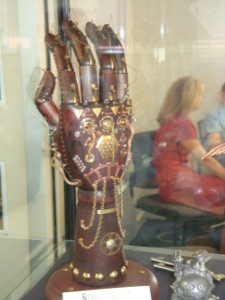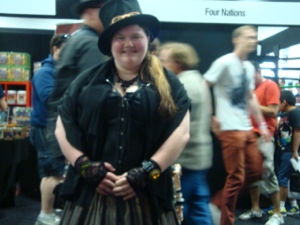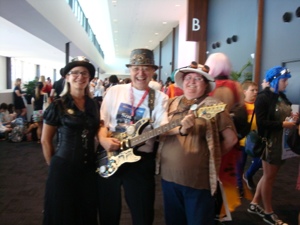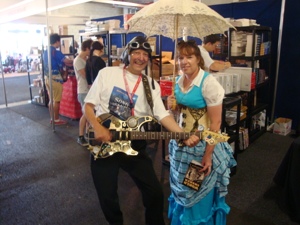Now home after the Voices on the Coast Festival on the Sunshine Coast. Beautiful weather, great audiences – and such a pleasure to catch up with authors I knew as well as meet some I’d never met before. The organisation ran smoothly and perfectly – thanks to Kelly Dunham of Immanuel College. Here she is, testing my guitar:

The festival – of children’s and YA literature – lasted for two days, and some of the presenters were (in order of timeslots through the program) – Marc McBride, Sue Lawson, Sally Murphy, David Lovegrove, Michael Bauer, Stephen Axelmsen, Tristan Bancks, Leah Giarratano, Dave Hackett, Leigh Hobbs, Steohen Herrick, Robert Hoge, Morris Gleitzman, Louise Cusack, Belinda Jeffrey, Pamela Rushby, Anita Heiss, Jeanette Rowe, Sarah Davis, Chris Collins, Will Kostakis. Some line-up!
I did 4 presentations, 2 workshops, and there was the Festival launch dinner on Wednesday evening too. All in all, a great time! But, as usual, I totally forgot to bring out my camera – the photo with Kelly above was taken at the very very end. However, I did get a photo in the Sunshine Coast Daily – in fact I got to be the headline item on the front page!

I guess I got to star because I had the steampunk hat and the steampunk guitar! The kids look to be having a ball!
Archive for the ‘Uncategorized’ Category
Voices on the Coast
April 25, 2014Bye bye Perth
March 30, 2014Friday was my last day in Perth – at Santa Maria College in Perth. Yet another school with a fabulous view over the Swan River –

Here’s the view including me and Anthony Phillips (Head of English and also an author).
Memo to self: don’t have pictures taken with sun coming in from behind!
I passed the evening watching Noah with Russell Crowe (so-so), then flew back East on an overnight flight with Tiger. Now I know why they call them red-eye flights!
More schools
March 27, 2014Wednesday I had a crazy day, starting way way in the northern suburbs of Perth, at St Stephens in Tapping –

Then all the way down to the southern suburbs, to Lumen Christi in Martin. Luckily it was outside of peak hours, so I could use the freeway and it took not much more than an hour. Here’s the library staff at Lumen Chisti – Lynley, Jonah and Janet –

Today (Thursday) was better organised – in fact my two schools were just round the corner fom one another in Mosman Park. Which was just as well, because I went from Iona Presentation College to St Hilda’s and then back to Iona again. Both of them girls’ schools – here’s the winner of the free giveaway copy of Song of the Slums at Iona –

There was a Steampunk display there too, which included a glass case full of wonderful Steampunk jewellery by Michelle Murray (Steelhip Design). I’ve put a sample at the end of this message.
And finally the auditorium at St Hilda’s. It seats 900, with a galllery level too, not visible in the photo – in fact, most of it isn’t visible in the photo. No kidding, it was the biggest auditorium I’ve ever done a talk in.
Back from Myanmar
March 8, 2014(WHICH USED TO BE CALLED BURMA)
So much packed into a mere 10 days! I loved Myanmar, and I’m so glad I went before it changes. (Maybe more good changes than bad changes – but it won’t be the Myanmar it was.)
We did the tourist circuit, Aileen and I. Hard not to, unless you’ve got heaps of time and means of access. There are planes that go round in order from Yangon to Bagan (used to be Rangoon and Pagan), then on to Mandalay, then on to He Ho (for Inle Lake), then return to Yangon. None of the flights are much more than an hour, but the roads aren’t too good for high speed travel.
We thought we were OK going at the end of their winter, the cooler half of the dry season, but cool in Myanmar means something else … like close to 36 degrees. I guess January might have been a couple of degrees colder, in the very depths of their winter! The good thing was we had a siesta in the hottest part of the day, except one day in Mandalay (phew!) and the two last days at Inle Lake (which was higher up, plus we were on the water most of the time, so not so hot). Aileen had thought of buying us fold-up umbrellas with double-layered skins (or whatever you say for umbrellas), and, yep, there were plenty of Burmese also walking around carrying umbrellas like parasols.

Not so smart were all the long-sleeve shirts we took over – as protection against the mozzies. Myanmar is known for dengue fever, and unlike malaria there are no pills or vaccinations you can take against dengue. The real curse is that the dengue-carrying mozzies are a different kind to the malaria-carrying ones – and they’re active in the daytime! So long-sleeve shirts would’ve made sense except for the heat. Instead we used Bushman’s Insect Repellent, the strong one with 80% DEET (‘Agent Orange’, Aileen called it). Don’t know what effect it might have long-term, but short-term it’s greasy and sticky and unpleasant on the skin.
It was good the hotels had effective air-conditioning – and quiet-running at night. We did well for hotels.
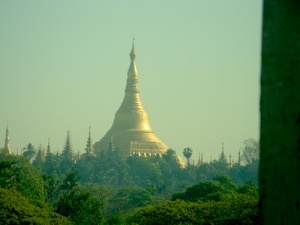
VIEW FROM HOTEL WINDOW IN YANGON (SHWEDAGON PAGODA)
Harder mattresses than we’re used to, but that’s just the Myanmar way – and we got used to them, Hey, maybe they were better for us. Some of the rooms were really spacious, and everywhere teak, teak, teak! Burma was always famous for its teak hardwood – and when you see some of the wooden monasteries and the way they’ve survived for centuries, or the great piers holding up houses in Lake Inle – yeah, teak is an amazing type of wood. Closest thing to stone!
I’ve done hotels, so I’ll do food next. We were with a group of two other Aussies and two Poms, and went out together for dinners and lunches when we felt like lunch. Meals are wonderfully cheap (unlike accommodation, which is way under-supplied for the demand). We ate Burmese when we could, Chinese when we couldn’t, and the cost of an average main course was about US$3-4. Another US$2 for a two-can size bottle of Myanmar Beer (best local) or Tiger Beer … it’s no wonder we brought back three-quarters of the US dollars we took over.
I should explain – we took over US dollars because that’s the only practical way to take money. No credit cards in Myanmar, and no ATMs that work on international cards. US dollars are the only currency you can change into the local currency, Khat (said ‘chat’) – or you can usually get by just using the US dollars themselves. Easy to convert in your head, because US$1 = 985 Khat – all close enough to an Aussie dollar. But when you exchange, you tend to get 1,000K notes – so our initial US$200 exchange gave us a mega-wad of 200 paper notes.
The snag with US dollars is that they have to be ‘pristine’ (that’s the word used when we went to buy them in Oz), i.e. not stained or marked or crumpled or even folded. Even the least imperfection, and they’re not acceptable. We carried ours around between two thick slabs of cardboard!
I got distracted from talking about meals. Burmese food is especially curries, served with rice, and the curries are delicious, not as hot as Indian, great flavour.

CURRIES, SUGAR BANANAS, MINI-MANDARINS
Only trouble is, the Burmese believe in oil – they especially like a thin layer of oil on top of the curry for preservative purposes. I suppose it preserves the meat, but it doesn’t preserve the arteries. Since the Burmese version of Chinese food tends to be oily too, there’s not much you can do about it. We had an Indian Indian meal on our last night in Yangon, and French fine dining in the resort hotel at Inle Lake (French owner, French-style cooking) – which was still cheaper than average Thai or Vietnamese in Australia.
Inle Lake resort was a place you could only reach by boat (like most everywhere around the Lake), and the Bagan hotel was secluded, set among trees. The other two hotels were in the biggest and second biggest city in the country, Yangon and Mandalay. The posh embassy area in the case of Yangon, a cruddy downtown area in the case of Mandalay (commercial and workshops, not even interesting restaurants around).
City streets in general were, well, Asian – bustling, dirty, colourful, decrepit, holes in the pavement, shops spilling out all over the place. A sort of functioning chaos. Less frantic and less dirty and smelly than India, and not as much spitting of betel juice.
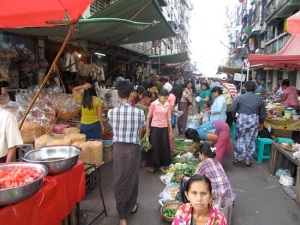
As for the pavement on the other side of the highway – well, like the other bank of a wild, rushing river. You just had to pick your moment, take your life in your hands and rush like a bat out of hell. It’s specially disconcerting that cars in Myanmar have their driving wheels on the same side of the car as us, but drive on the opposite side of the road.
I say shops, but there were more street vendors than shops in the Western sense. Surprisingly, the most widespread shops would have been the ones selling mobiles – I guess they’ve taken off in a big way in the last few years. Not much use for tourists, though, because international dialling is hard to impossible, and I’m not sure you could even buy a SIM or mobile for local calls without going through a police identity check. Still, it was amazing the way our local guides all had smartphones and used them all the time.
Talking of police, they weren’t omni-present, though we did go to a shopping mall (a supermarket and a couple of shops – tiny for us, but one of the main ones in Yangon) and there were police manning all four entries and exits … each with their own little desk, running their electronic wands over everyone who wanted to come in. A lot of army vehicles too, outside Yangon. But no, it didn’t feel oppressive.
The villages around Bagan and Inle Lake were a different story, so calm and peaceful, like stepping back in time. 
There were villages in Bagan with goats and chooks and humpy-backed cows in the back gardens, just as natural as could be. And village markets, a million piles of fruit and vegetables, meat and fish – and a traditional novitiation ceremony, where five-year-olds are paraded around the village, with feasting and music, before going off to join a monastery.
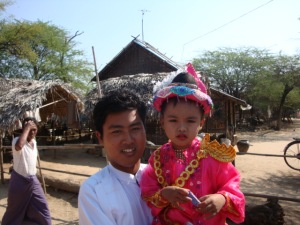
NOVICE AFTER CEREMONY
(They’re not trapped there, though – plenty of home visits and plenty of opportunities for opting out as they grow older)
Dogs and cats are everywhere, in both cities and villages – and the amazing thing is that they always seem to be sleeping. They’re never fat, but they seem to do all right for themselves. In Mandalay, I swear there was one gingery cat that kept running around ahead of us to lie down fast asleep – at least a dozen times. At least, it always looked the same … though, come to think of it, it looked the same at Inle Lake too.
That reminds me of the kids selling souvenirs at Bagan. Aileen made the mistake of saying “OK’ when a girl with an armful of bracelets said ‘See you later.’ Fatal mistake In Myanmar! We hopped on the minibus a minute later and drove several kilometres to another temple. Guess who was there waiting for us, the moment we stepped out into the sunshine? Seemed like a miracle – or a recurring nightmare – but there was a rational explanation. The girl and her friend had jumped on a motorbike and trailed the minibus all the way.
That’s one thing about souvenir sellers in Myanmar – ‘See you later’ is almost a signed contract. Another is that they remain genuinely nice and helpful even after they’ve given up hope of selling you anything … they’ll still point you in the right directions, warn you against uneven stones, etc etc. But they are persistent – in a gentle, non-aggressive way, as befits a Buddhist country, but very, very persistent. Also young, mostly kids. I guess it’s a sign of things to come, alas …
Buddhism – I’ve said the most important word in the story of Myanmar. It’s a Buddhist country through and through. Every aspect of life rotates around Buddhism. It’s not oppressive at all, because Buddhism is mostly an easy-going, non-prescriptive, non-rule-bound sort of religion (OK, OK, I know there are Muslim tribes in provinces we didn’t visit that would disagree.) The Buddhist sense of the sacred mingles freely with the everyday, not formal or set apart. But by the same token, it’s part of the daily system of life: everyone needs to do things that gain ‘merit’, e.g. donations, volunteer work (maybe even pointing a tourist in the right direction!), and much merit-doing ties in with the monks as the representatives of spiritual worth.
Monks are everywhere, in their dark-red, over-one-shoulder robes, and so are monasteries. The monks gather alms, volunteers help them by cooking or cleaning or whatever for them – it’s a total social system.

VOLUNTEERS SWEEPING AT SHWEDAGON PAGODA (FIRST LINE, FOUR MORE COMING)
The monks run schools for children of families that can’t afford to send their kids to government schools; and the novices grow up with simple accommodation, very early rising, and a great deal of study and reciting. Vegetarianism is optional, it seems. Maybe the system in the Medieval period in the West started out similar, I don’t know, but these monks didn’t seem to have accumulated wealth or fallen into less-than-holy ways.
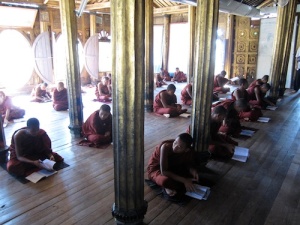
YOUNG MONKS STUDYING
There are nuns too, in their bright pink robes, but nowhere near as many. Perhaps because girls aren’t thought to be as high up on the levels to nirvana. One woman in our group was a Buddhist and insisted that there’s no sexism in Buddhist teachings as such; however, there are some temples where of women are forbidden to come up and apply gold leaf to the statue of the Buddha. We spent some hours at a nunnery in Mandalay, where the nuns cooked our lunch – after we’d done the right thing by offering food to the nunnery. The offering of food involved a ceremony where we sat around a laden table and lifted the table in the air three times. The nuns ate before us – they’re not allowed to take any food after noon – and thanked us with a chant that seemed to go on for about fifteen minutes. I guess that sounds very spiritual – but on the other hand, when they heard that the Poms in our group came from Manchester, they clapped their hands and cried delightedly. “Man U!” “Man U”. No doubt they followed the soccer on their TV set.
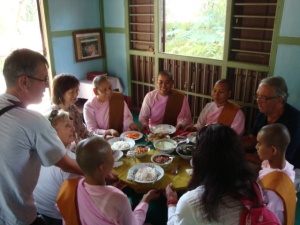
RAISING THE TABLE, OFFERING THE FOOD
Almost all the notable architecture in Myanmar is Buddhist: pagodas (solid bell-shapes, generally containing a buried relic); temples (containing a statue of the Buddha), prayer-halls, cave-temples and monastic buildings. The main principle of Myanmar architecture is that you can never have too many temples – or too many statues of the Buddha. Aileen was getting a bit Buddha-ed out by the end, and definitely temple-d out by the end of Bagan. I mean, think of an area of at least a hundred square km, with temples sprouting up like mushrooms everywhere. A thousand? Two thousand? I forget the numbers.
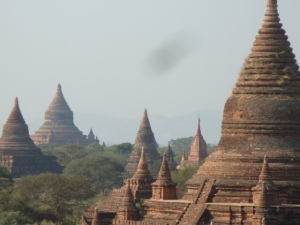 I can take a lot of buildings, and I really like the Burmese style of temple. I just wish one didn’t have to take off shoes and socks every time one enters any kind of religious building.
I can take a lot of buildings, and I really like the Burmese style of temple. I just wish one didn’t have to take off shoes and socks every time one enters any kind of religious building.
Bagan was the place I knew about beforehand. I didn’t know about Mandalay – except the name – so I was amazed and blown away by the wooden monasteries. The buildings carved in teak, as always, and standing on pillars of teak – here’s the most spectacular, called the Golden Palace Monastery. A king’s donation to his favourite monk, and originally covered in gold outside as well as in.

GOLDEN PALACE MONASTERY, MANDALAY
The other Myanmar in Myanmar is that you can never cover anything in too much gold leaf. They love their gold! That is, they show their devotion by applying gold leaf – which they bring for themselves or buy – wrapped between sheets of paper – at nearby shops. Only problem – if you keep on applying more and more gold leaf to a statue, it ends up looking like a sort of golden blob.
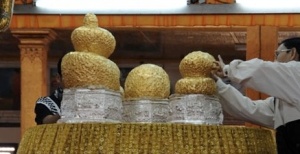
BUDDHA BLOBS AT PHAUNG DAW OO PAGODA
Yep, those were once little statues of the Buddha (and still are, somewhere deep inside).
Another thing it seems you can never have too much of: sunsets! We climbed up to high places to watch the sun go down everywhere we went. OK, I say climbed, but actually we went up by multiple escalators to the Shwedagon Pagoda in Yangon and another hilltop pagoda in Mandalay. It’s a tourist thing, obviously, but I think it must also be a Buddhist thing. The best of the bunch was the sunset from the top of a high a very steep-stepped monument in Bagan.

SUNSET AT BAGAN
What else? Inle Lake had pagodas and markets and the usual, but it was special because the inhabitants lived a totally water-borne existence. The lakeside villages were like peasant Venices – wooden or woven-bamboo houses raised up on stilts, lined up along the sides of water-streets and water-alleys.

HMM … WISH I HAD A BETTER INLE LAKE PHOTO
There were floating gardens too, created out of mud and roots and weed, anchored in place in the shallows of the lake by vertical poles. You’d hardly know they weren’t ordinary vegetable plots and gardens except for the poles sticking up.

IT’S REALLY FLOATING!
Phew! That was a long blog. It had to wait till I got back because I didn’t take my iPad – there’s wifi in Myanmar but it never seems to work. Ditto computers in hotel foyers – trying to get an international connection takes, well, more than 30 minutes (I gave up on half an hour).
I want to end on a recommendation. Go to Myanmar and go soon – it’s a wonderful country!
flying home today
November 17, 2013Only the packing left to do. I’ve been staying with David Cornish and his wife Tiffany – perfect hosts! Thanks, guys. Here’s David poised over computer and breakfast –

Last night we wrapped up with an author’s dinner – with Ineke in the centre, of course.
Left to right, that’s me, David (D.M.) Cornish, Joel Garner, Colin Taber (my iPad wants to change you to Tabernacle, Colin!), Sean Williams and Ineke Prochazka.

Omigod, what happened to my mouth? Some fragment of food left over from dinner, maybe. The pic was taken later when we were having chocolate – hot chocolate, churros … it’s become a tradition. Jay Kristoff had to leave straight after dinner.
End of Supanova
November 17, 2013Sunday gone, Adelaide Supanova over, alas! Here are some more of the best Steampunk costumes –

Stephen Starke above, and Stephen Baragwanath below

Followed by Shiralee Parkinson
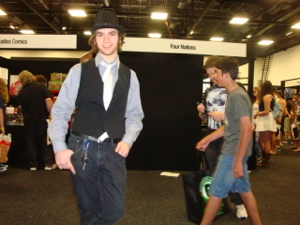
Last but not least, Mark Griffiths

Way to go, guys! And those were only the ones I snapped – I can think of more I missed.
Steampunk costumes at Supanova
November 16, 2013Adelaide & second Supanova
November 16, 2013Time to catch up on some pics. I stayed for three nights at the Tollgate motel in Adelaide – driving up the hills on the back way heading north, the view was spectacular, over the whole city to the sea –

I fitted in four school visits, to Seymour College, St Ignatius, Cabra Dominican and Kildare. Here’s Ruth Massie, Head of English at Seymour, getting into the Steampunk mood –
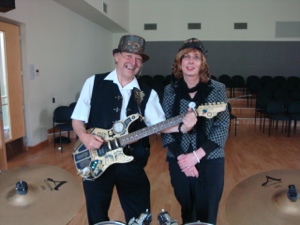
Here’s one of the prizewinners with her free giveaway copy of Song of the Slums at Cabra
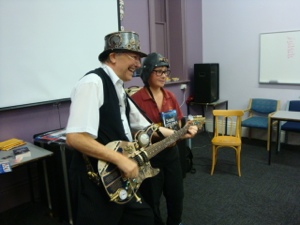
And here’s Richard doing his shtick at Kildare –

Now I’m staying chez David Cornish and Tiffany, and Supanova’s half way through already. More anon!
Authors at signing
November 10, 2013I took a couple of pics at the end of Sunday’s signing (when crowds had shrunk enough for me to get a clear picture!)

Left to right – Jay Kristoff (Stormdancer, Kinslayer), Joel Shepherd (Sasha, latest in the Trial of Blood and Steel series), Colin Taber (Ossard Trilogy, The Landing), Stacey (our guardian angel at Supanova, looking after us and shepherding us wherever we needed to be), and D.M. (David) Cornish with his wife (Monster Blood Tattoo).
Not included – Ian Irvine who’d left to catch a plane, Scott Baker, temporarily wandering, and Steve Worland installed at the Penguin counter.
And in reverse order –

Right to left – David, Stacey, Colin, Joel and Jay.
Great bunch of guys! George R.R. Martin was generally sitting round the corner from David, with his (very long) queue approaching from another direction – but not in the moment when I took the pic. (I was generally next along from Jay)

